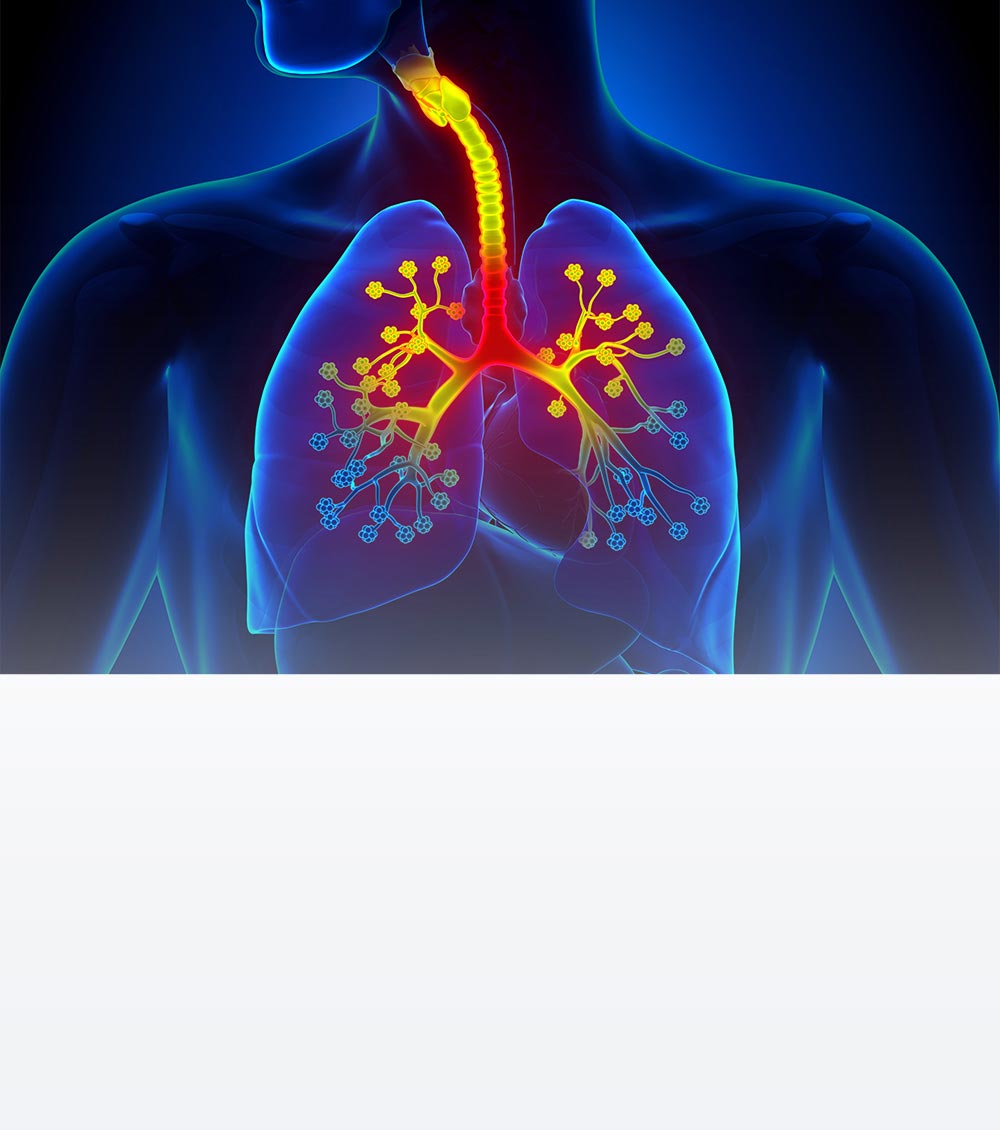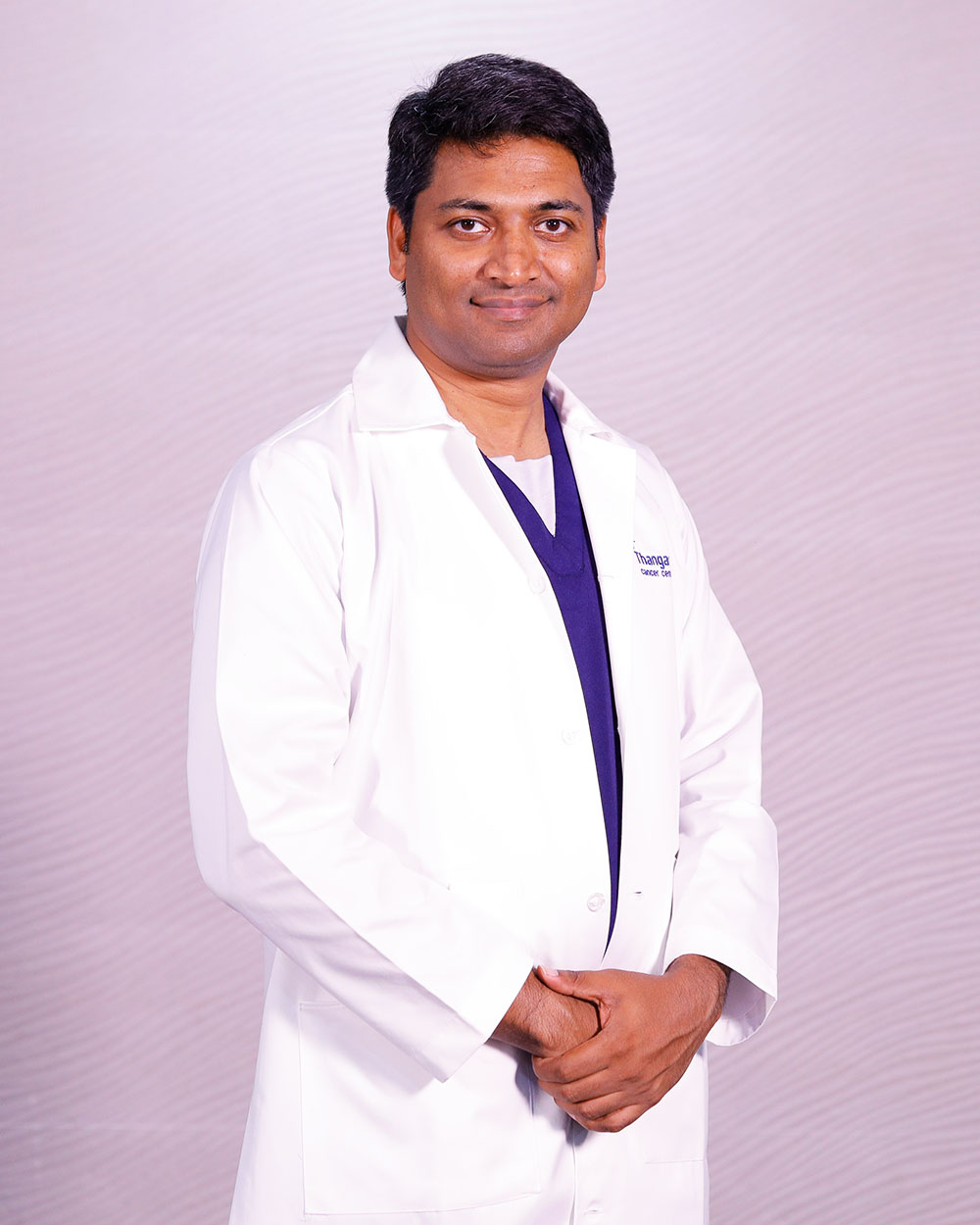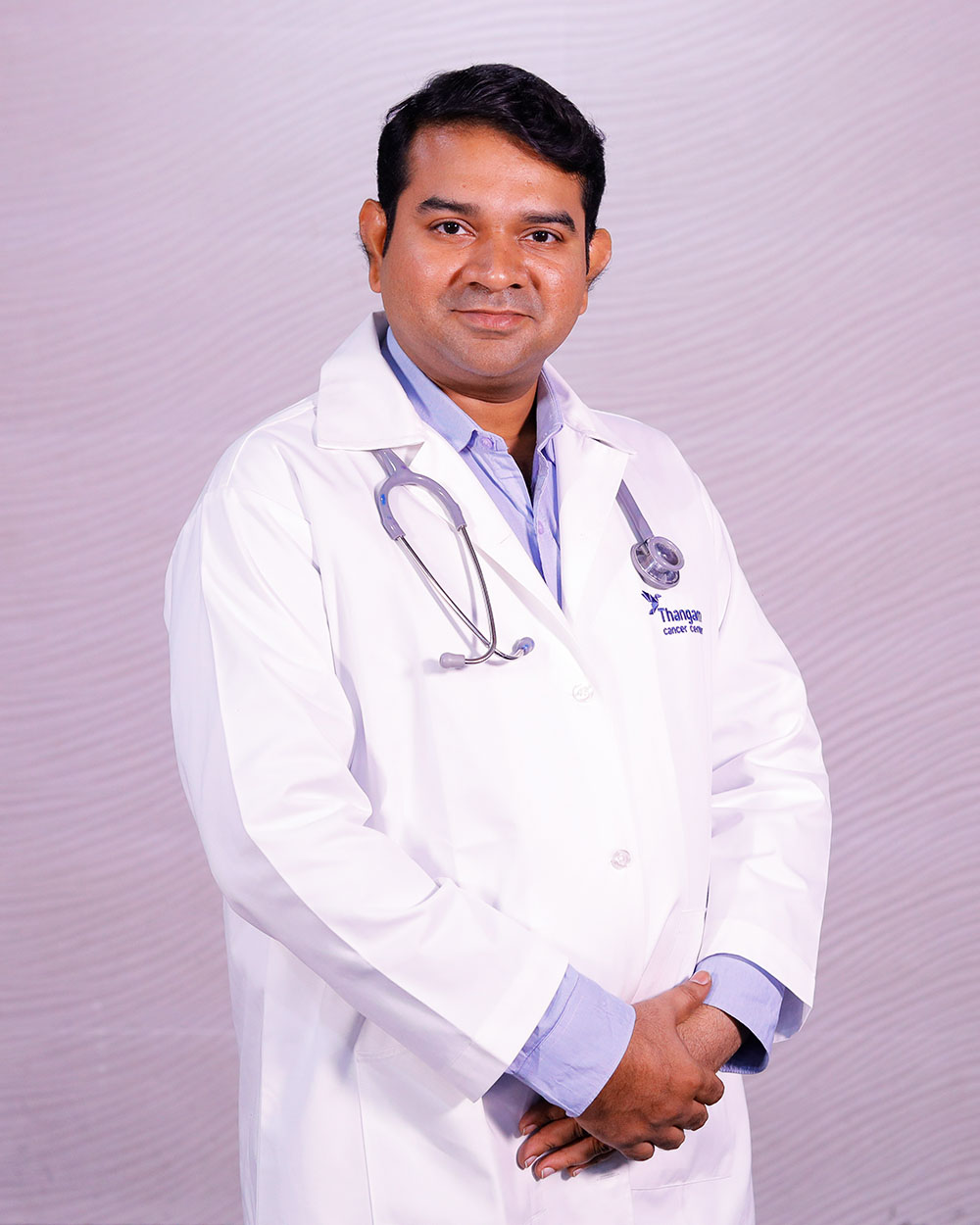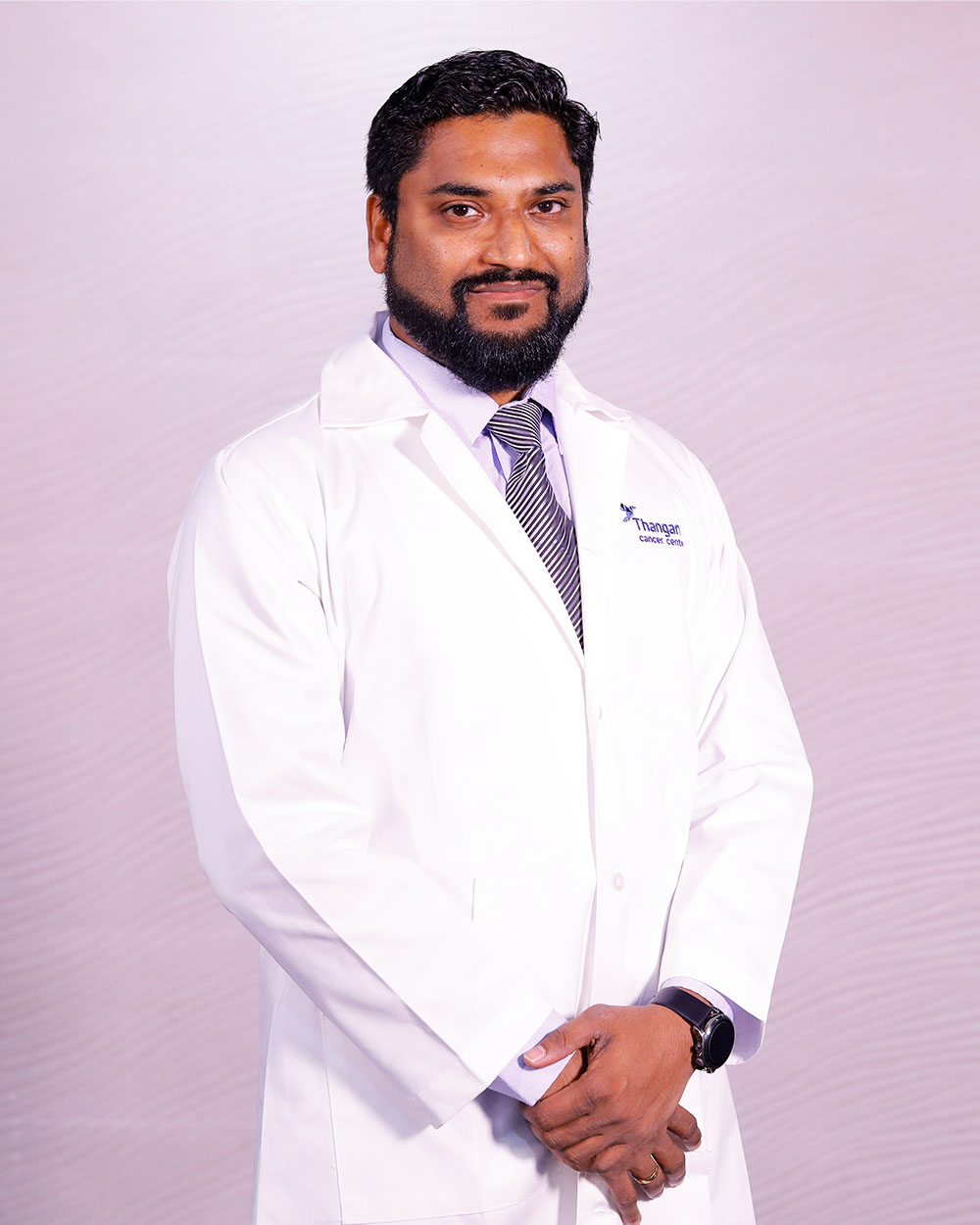Lung Cancer
Lung cancer often occurs in people inclined to smoke, and even in individuals without smoking or tobacco addiction, and is slowly becoming the top reason for cancer-related deaths in India and Asia.
Lungs are a pair of spongy organs in the chest that help inhale oxygen and release carbon dioxide. During inhalation, the air enters through the mouth and nose and reaches the lungs through the windpipe.
The windpipe called the trachea further divides into small tubules called bronchi, which further divide into smaller branches called bronchioles. The bronchioles further divide into tiny air sacs called the alveoli.
In lung cancer, the cell linings of these structures- the bronchi, the bronchioles or the alveoli, start to divide at a very high-speed leading to the formation of tumours which affects the normal breathing process.
Symptoms of Lung Cancer:
Symptoms vary depending on the category and staging of lung cancer and are similar to other lung diseases.
It is important to note that symptoms of lung cancer are similar to symptoms of other lung diseases and if you experience any of these associated symptoms, you should see your doctor for a medical evaluation.
Other symptoms of lung cancer
Other symptoms that exist in the case of lung cancer are:
Types of Lung Cancer
Based on the cell structure of the tumour lung cancer is classified into two types:
- Small cell carcinoma
- Non-small cell carcinoma
About 80 – 85% of lung cancers are non-small cell lung cancer abbreviated as NSCLC and differentiated as below:
- Adenocarcinoma
- Squamous cell carcinoma
- Large cell carcinoma
These subtypes differ in tumour formation and characteristics but have similar treatment strategies and prognoses.
- Neuroendocrine carcinoma
- Adenosquamous carcinoma
- Sarcomatoid carcinoma.

Diagnostics Facilities
Advanced Cancer Diagnostics
Advanced Cancer Treatment
General Diagnostic Facilities
Causes of Lung Cancer
Multiple factors cause lung cancer, which includes:
- Genetics: According to studies, if members of the immediate family have lung cancer, chances are that you are at a higher risk of developing the disease. Changes in the DNA can make cells cancerous however consultants are sceptical about the reasons/risk factors that cause modifications to the DNA. These DNA changes can be inherited or acquired during a lifetime from exposure to various factors.
- Age: The risk of lung cancer increases with age.
- Past lung diseases: Exposure to other lung diseases such as tuberculosis or bronchitis can cause inflammation and scarring of the lungs, increasing the risk of cancerous growth.
- Exposure to radiation or radiation therapy.
- Smoking: Smoking tobacco, cigar, etc. can increase your chances of having lung cancer as they contain substances, which are carcinogenic in nature. As soon as your body is exposed to these carcinogens, the cells start to degrade. Initially, your body can repair/heal itself from the cell degradation process but continuous exposure weakens the body’s immune system. It is the leading cause attributing to 80% of fatal cases.
- Tobacco chewing: In India, chewing tobacco is very common, contributing to an increased number of lung cancer patients.
- Passive smoking: It is the exposure to second-hand smoke (from an active smoker), which happens at work, at home or in public places.
- Diet: An unbalanced diet, which does not provide your body with all the required vitamins and minerals can increase the risk of cancer.
- Environmental factors: Certain environmental factors increase the risk of lung cancers in individuals, they include:
- Exposure to Radon: Radon is a naturally occurring radioactive gas, which is a result of Uranium breakdown in the soil.
- Exposure to Asbestos: This is an industrial material used for construction purposes or as a fire retardant.
- Arsenic in drinking water is associated with higher risks of cancer.
- Air pollution: According to studies, 5% of fatal lung cancers worldwide are a result of air pollution.
When to see the doctor?
It’s crucial to consult a doctor if you are experiencing symptoms that share similarities with lung cancer. The consultant examines your medical history and risk factors and conducts a thorough physical examination. Depending on the diagnosis of preliminary tests, the doctor recommends further diagnostics to confirm the prognosis.

Prevention of Lung Cancer
Only a few categories of lung cancers can be prevented, however, you can take care of the following to reduce the risk.
Staging of Lung Cancer:
Lung cancer treatment depends on the “Stage” of the disease as treatment strategies vary according to the extent of disease spread. The following tests are mandatory for diagnosing and treating lung cancer.
All the above tests are available and performed on a routine basis at our centre.
What are the clinical tests done when Lung cancer is suspected?
- Physical examination: Our doctor will check your vital signs like oxygen saturation levels, heart rate, and blood pressure, including auscultation for lung sounds and lymph node examination. This physical examination may indicate the presence of symptoms related to lung cancer.
- X-Ray: A Chest X-Ray PA view or posteroanterior view or X-Ray view from the back to the front of the chest wall reveals the concerned areas in the lung. A lateral view or view from the side also is taken to verify the presence of tumour/cancer cells.
- CT scan: Computerised Tomography scan is about scanning internal organs by taking pictures as the equipment moves around your body, providing a precise vision of the condition of internal organs. It helps determine the presence of tumours or cancers better than standard X-rays. CT scan of the chest, abdomen and brain may be done to investigate primary and metastatic lung tumours.
- Bronchoscopy: An endoscope, a thin-lighted tube inserted through the mouth into the lungs to examine the bronchus and lungs. This instrument can be used to perform a biopsy to collect cell samples for further examination. Collecting tissue samples in case of large tumours is comparatively easy and does not require hospitalization; this process can also be performed under sedation or using local anaesthesia.
- EBUS – Endobronchial Ultrasound: This is a special type of endoscope consisting of an Ultrasound probe with a camera at its tip, which gives a clear vision of the airways and also guides consultants during the biopsy procedure to obtain tissue samples. Collecting tissue samples in case of large tumours is comparatively easy and does not require hospitalization; this process can also be performed under sedation or using local anaesthesia.
- Sputum cytology: It is the thick mucus discharged during cough cycles, pathological studies of the mucus help diagnose malignant cells and confirm lung cancer. This test has limitations since there are chances that the mucus might contain non-cancerous cells due to inflammation that mimics cancer cells.
- Magnetic Resonance Imaging: This technique uses magnetic radio waves and a computer to produce images of body structures. A movable bed passes through the magnetic scanner, enabling a detailed view of the tumour’s location. MRI poses a risk in examining individuals with heart pacemakers, metal implants, artificial heart valves and other surgical implants due to the action of magnetic forces. MRI of the brain is also taken since the brain is also affected in most lung cancer patients.
- Positron emission tomography scan: Pet scan, a specialized imaging technique using short-lived radioactive drugs to produce three-dimensional coloured images, measures metabolic activity and tissue functions to determine the tumour type and growth. The radioactive drug accumulates in certain tissues and emits positrons, which encounter electrons, causing a reaction to produce gamma rays, wherein a scanner records these gamma rays and maps the concerned area.
- Blood tests: This reveals the biochemical or metabolic abnormalities in the body that accompany cancer. In bone cancer, calcium levels are elevated as well as serum alkaline phosphatase levels and a spike in liver enzymes SGOT and SGPT signal liver damage.
- Molecular testing: Molecular genetic testing looks for genetic mutations in the tumour. These mutations can be looked for in the epithelial growth factor receptor and the anaplastic lymphoma kinase genes. MAPK and PIK 3 are genes that mutate and specific therapies are given to these patients whose tumours have these gene alterations.
- Lung biopsy: Imaging tests might help, but biopsy is the most significant test for cancer diagnosis, which also helps determine the type of cancer.
Which specialists are responsible for treating lung cancer?
Lung cancers are typically treated by a specialist team comprising a Thoracic Surgeon, Medical Oncologist, Pulmonologist, Interventional Radiologist and Pain/Palliative Care specialists.


Treatment for Lung Cancer
Thangam Cancer Center has a dedicated Thoracic Oncology Unit with all specialists and investigations necessary for the treatment of lung cancer.
- Neoadjuvant: Patients undergo chemotherapy prior to surgery or radiation to minimize the cancer spread.
- Adjuvant: Patients undergo chemotherapy after surgery to eliminate the remaining cancer cells.
- Palliative chemotherapy: Patients undergo chemo during the advanced phase ie. Stage IV to relieve them of symptoms and improve their condition.
Doctors

Dr. Saravana Rajamanickam

Dr. Bhavesh Poladia

Dr. Deepan Rajamanickam



